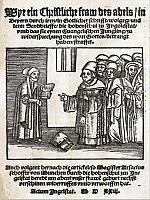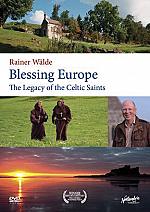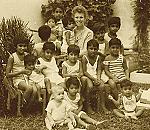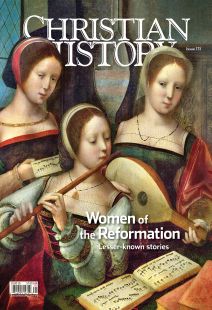“God my Lord is even stronger”
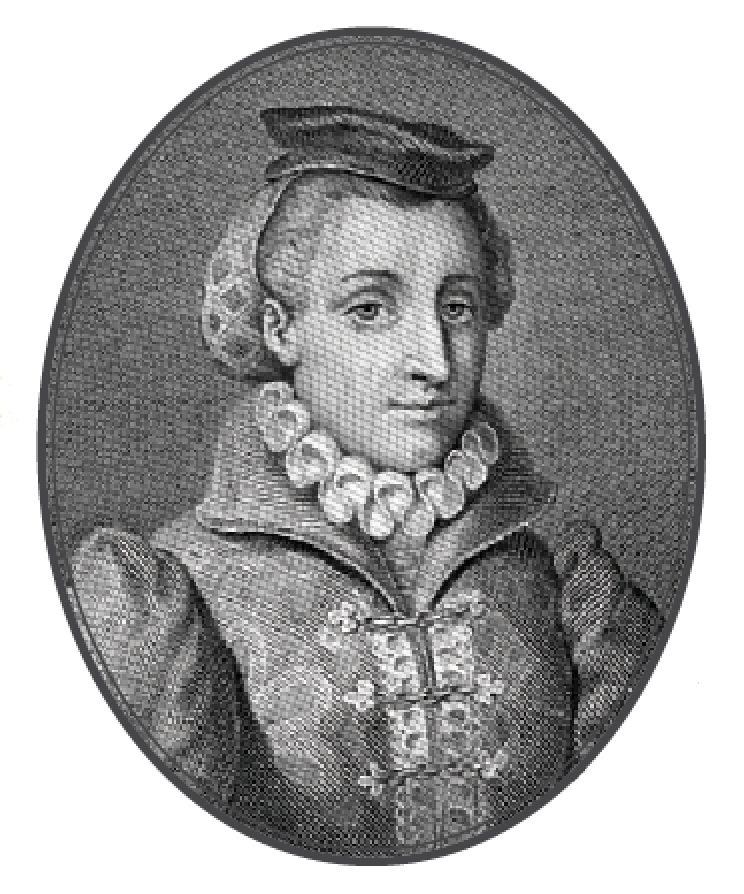
[Anna Bullinger]
Katharina von Zimmern (1478–1547)
Katharina von Zimmern was the last abbess of the Benedictine Fraumünster Abbey in Zurich. The large church with a splendid courtyard is still located at the heart of Zurich on the Limmat River near the mouth of the Lake of Zurich.
Katharina von Zimmern entered the Fraumünster convent when she was 14 years old. Four years later in 1496, she was named abbess of Fraumünster at the young age of 18. Von Zimmern bore responsibility for substantial farmlands, estates, and properties along the banks of the river.
According to the old laws from the early Middle Ages, the abbess of Fraumünster was the ruler of Zurich; but by 1518 both her power and the convent were in decline. Only four women still lived and worked in the Fraumünster Abbey when reformer Huldrych Zwingli and the Zurich city council asked von Zimmern in the early 1520s to close and give the abbey and its properties over to the city of Zurich. Both church and state in Zurich had made the sweeping all-inclusive decision to become a Reformed city.
In December of 1524, von Zimmern abdicated her rights and conceded her property to the city. In her brief speech of abdication, she said that she had freed her conscience and consciousness, gained insight from honorable people, and as a Christian with the strong hope of living her life according to godly order, she agreed to turn her abbey over to the city of Zurich.
Now 47, von Zimmern stood at the beginning of a Reformed life. Although she had the right to remain living in the abbey, she married Eberhard von Reischach and had two children; her husband was briefly exiled from the city and she went with him, but both returned in 1529. After von Reisach died in the battle of Kappel in 1531, the last abbess of Zurich bought a house there where she resided until her death.
Helena von Freyberg (1491–1545)
Helena von Freyberg of the region of Tirol was born of the lower nobility but chose to leave her inherited comfortable life to participate in the radical Reformation. She and her husband, Onophrius von Freyberg of Hohenanschar, had four sons, all of whom became knights. When Tirol banned Anabaptist practices, she fled to their castle in Münichau. Von Freyberg and her entire household (excluding her husband) received a “second” baptism as adults in March of 1528.
Pilgram Marpeck (d. 1556) led the community of Anabaptists to which von Freyberg belonged. The group based its interpretation of the Bible on a synthesis of mysticism, apocalypticism, and separated congregationalism. After her baptism von Freyberg’s home served as the center for Anabaptist activity in the area—she ran a house church from 1527 to 1529, visited 36 Anabaptists in prison in 1528, and supported others financially. In 1529 a recanting Anabaptist gave the authorities the evidence they needed to arrest von Freyberg. She escaped to her husband in Bavaria, then to Eppan, and finally left Tirol.
Von Freyberg settled in Constance, a Lutheran area, where she influenced the local Anabaptists; ejected from there, she went back to Münichau. In 1533 the government asked her to recant her Anabaptist beliefs to continue living at Münichau. She considered recanting in public, which would have weakened the Anabaptist cause, but finally did so only in private. Afterward she fled to Augsburg. Her exile did not diminish her enthusiastic support for the Anabaptist community in Augsburg until the authorities arrested her on Easter 1535. After testimony in court, she was put in chains overnight and released the next day. Her husband and sons arranged that she could remain in Augsburg until her death.
Von Freyberg testified about her Anabaptist faith when she tried to mediate between Marpeck and Caspar Schwenckfeld (1490–1561; see Christian History issue #21 for more on Schwenckfeld). As part of this, she wrote her spiritual biography, now in the Kunstbuch, a collection of unpublished writings from 1527 to 1555 by members of the Marpeck circle. Like Katharina von Zimmern’s abdication, von Freyberg’s confession was the result of a profound and embodied biblical foundation combined with willingness to live according to her convictions:
The devil has covered me over many times and distorted the light and made me white while I was black and perverted the Holy Spirit into a spirit of flesh. This is what (the devil) does in spiritual things; he presents himself as if he were white as an angel (and very humble). But God my Lord is even stronger and deprives him of his power and might through Jesus Christ, His beloved Son.
Ursula Jost (c. 1500–c. 1532)
During the early years of the Reformation, monasteries and convents closed, members of the clergy married, and a host of fresh expressions of religious freedom began to sprout up all over Europe. Strasbourg prided itself on being open to various strands of the new faiths; three different Anabaptist groups, members of the radical Reformation, found homes there.
Ursula Jost belonged to the group of Anabaptists that converged around controversial lay preacher Melchior Hoffman (1495–1543); Jost and others in the group were known for their prophetic visions (see “Dangerous pamphlets,” pp. 34–37). Ursula Jost’s first vision was recorded in 1525. She married Lienhard Jost, who was also a visionary—confined involuntarily to an insane asylum for a time because of it—and they lived together with their daughter Elsa on the southeastern edge of Strasbourg near the Butcher’s Gate until Ursula died sometime before 1539.
In the print shop owned and run by his wife, Margarethe Prüss, Balthasar Beck recorded and published 77 of Jost’s visions in Prophetische Gesicht. Often apocalyptic in nature, her visions pointed to the end times spoken of in the Bible or to times of crisis: serpents and toads, manna, the cross, ladders to heaven, the pope being dragged into hell, and people rising from their graves.
What Jost saw reflected the troubled times she lived in as the peasant revolt of the 1520s and the overthrow of the Roman Catholic Church’s authority changed the world around her. Jost followed the pattern of biblical prophets: judgment and wrath versus patience and endurance, the ways of the world versus God’s ways. Her conclusion was that the crown of life will go to children who take the narrow path.
Anna Adlischwyler Bullinger (c. 1504–1564)
In Zurich Anna Reinhart Zwingli pioneered the role of the pastor’s wife as spouse to Huldrych Zwingli; Anna Adlischwyler continued it by marrying Zurich’s second antist (lead pastor), Heinrich Bullinger (1504–1575). Both Annas served as their husbands’ partners in ministry.
Anna Adlischwyler had inherited money, a house, and some household goods when her father died. Her mother, in turn, sent Anna to enter the Dominican religious order in Oetenbach in 1512 to honor his death.
After Zwingli claimed the pulpit to reform Zurich in 1519, the Zurich city council ordered in 1522 that all of the nuns in Oetenbach must hear the gospel message preached by Zwingli in his role as antist. Three years later Katharina von Zimmern resigned as abbess of Fraumünster, and all monasteries and convents were closed. Only a few stragglers were left; Adlischwyler was one. By 1526 only she and an elderly nun named Justina remained in Oetenbach.
Adlischwyler soon met Bullinger, and we know from his letters that he started courting her in 1527. He lost his patience after she refused to marry him in 1528. In 1529 he sent her a long letter about how a Christian wife should behave—this letter later became the center of his On Christian Marriage (see “Honorable and holy,” p. 11).
Bullinger’s diary recounts that Adlischwyler would not marry him because it displeased her mother. He took the matter to marriage court and also sent the most powerful men in Zurich to convince Adlischwyler to marry him; finally, shortly after her mother died, she conceded. After Zwingli died in the Battle of Kappel in 1531, Adlischwyler was the wife of the most powerful man in Zurich—the antist of Gross Münster (“great church,” the main Protestant church).
Adlischwyler became the mother of 11 children in 18 years as well as Zurich’s most welcoming hostess to people from around the world. Bullinger called Anna his beloved “Hausfrau,” generally translated as “housewife” but meaning something more like “home mom.” She fed and served everyone, from her husband’s theology students to persecuted people to the great thinkers of the Zurich Reformation and their wives; even Genevan reformer Calvin ate at her table.
Heinrich Bullinger called his family life “a joy” and mourned deeply when his wife died after caring for him and others when the plague struck Zurich in 1564. He wrote to his friend Ambrose Blaurer (see “Christ is the master,” p. 33) in Constance, “You know that the Lord has taken the staff of my old age, my loyal, chosen, and exquisitely godly wife. But the Lord is righteous, and his judgment is righteous.”
Anna Adlischwyler Bullinger was later referred to as the “Mother of Zurich,” and her strength and passion for her family and church served as a model for homes in which pastoral families lived and cared for others throughout the centuries.
Charlotte Arbaleste Duplessis-Mornay (1550–1606)
The magisterial Reformation and the radical Reformation involved people with the same central conviction of sola scriptura, the conviction that the Scriptures are the sole authority for faith and practice. But they went in two directions as they left Catholic doctrine and organization behind. The French ethnic Reformed, referred to as Huguenots, boasted innovative, brave, and pioneering women (see “Like mother, like daughter,” pp. 12–15) like those from the German and Swiss regions.
Charlotte Arbaleste was born in Paris in a time of crisis and conflict between French Catholics and Protestants. Though her father was Catholic and her mother Protestant, her well-to-do family was peaceable. Arbaleste chose the Protestant faith and married her first husband, Jean de Pas, Lord of Geuqueres, when she was only 17 years old. De Pas was killed at war before he saw their daughter, who was born in 1568.
Arbaleste got caught in the St. Bartholomew’s Day massacre in Paris in 1572, when assassins and mob violence broke out against the Huguenots while the leading figures of the Reformed movement gathered for a wedding in Paris. She managed to flee to Sedan, where she became famous for publishing her accounts of the massacre. There she met and married author Philippe de Mornay, Lord of Plessis-Marly (1549–1623). Philippe and Charlotte had eight children, but only three survived.
While Philippe argued in writing for the Huguenot faith, his wife raised their children and her daughter from her first marriage. She ran the household, and, just like Anna Adlischwyler Bullinger, entertained public figures—all in support of her husband while he wrote tracts to further the understanding of Reformed Christianity.
Charlotte Duplessis-Mornay also found time to write her husband’s biography, Memoires de Messire Philippe de Mornay, Seigneur du Plessis-Marli, continuing to work on it until she died in 1606 (seven months after the death of their only son).
The memories she shared of her husband’s life provide a significant and detailed chronicle of the historical circumstances and religious experiences of the French Huguenot movement, and they still aid us today in understanding the lives and roles of Huguenot women in the Reformation. Philippe outlived her, dying in 1623. CH
By Rebecca Giselbrecht
[Christian History originally published this article in Christian History Issue #131 in 2019]
Rebecca Giselbrecht is senior postdoc research fellow at the University of Bern, Switzerland, and affiliate assistant professor of the history of Christianity and spirituality at Fuller Theological Seminary. She is the editor of Hör nicht auf zu Singen”: Women in the Zurich Reformation and of Sacrality and Materiality: Locating Intersections and the author of many articles and essays about the Reformation.Next articles
Women of the Reformation: recommended resources
Want to learn more about lesser-known women of the Reformation? Check out these recommendations from our editors and from this issue’s authors.
the editors“The gates of Hell cannot prevail”
Von Grumbach’s letter to the University of Ingolstadt protesting the arrest and exile of Arsacius Seehofer for holding Lutheran views, excerpted here, became her most famous and best-selling piece of writing
Argula von GrumbachSpiritual Friendship: Recommended Resources
Want to learn more about the stories featured in this issue? Check out these recommendations from our editors and from this issue’s authors.
The editorsHaystacks, starry clusters, and baptizing bishops
How God used friendships to spark mission throughout church history
Jennifer A. BoardmanSupport us
Christian History Institute (CHI) is a non-profit Pennsylvania corporation founded in 1982. Your donations support the continuation of this ministry
Donate




